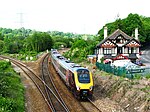Newton St Cyres

Newton St Cyres (, like "sires") is a village, civil parish former manor and former ecclesiastical parish in Mid Devon, in the English county of Devon, located between Crediton and Exeter. It had a population of 562 at the 2011 Census. The village is part of the Newbrooke electoral ward. The ward population at the above census was 1,520. Almost destroyed by fire in the early 1960s, its main point of interest is the Parish Church, built in the 15th century and dedicated to the martyrs St. Cyriac and his mother St. Julitta. Most of the church is in early Perpendicular style, built of local reddish 'trap', a volcanic stone from quarries at Posbury, with the exception of the nave pillars, which are of Beer stone. It contains the monument with standing effigy of John Northcote (1570-1632) of Hayne, lord of the manor of Newton St Cyres. Newton St Cyres railway station is on the Tarka Line from Exeter to Barnstaple and the Dartmoor Line from Exeter to Okehampton, but is located approximately 0.5 miles outside the village centre, and receives an infrequent service. Newton St Cyres is home to a public house, the Beer Engine, which is situated next to the railway station, and an Italian restaurant, Belluno, which was formerly the Crown and Sceptre public house. Traditional cheeses can be bought from the Quickes Farm shop. The village has a recreation ground with two football pitches, a cricket pitch and two tennis courts.
Excerpt from the Wikipedia article Newton St Cyres (License: CC BY-SA 3.0, Authors, Images).Newton St Cyres
West Town Road, Mid Devon
Geographical coordinates (GPS) Address Nearby Places Show on map
Geographical coordinates (GPS)
| Latitude | Longitude |
|---|---|
| N 50.768 ° | E -3.592 ° |
Address
West Town Road
West Town Road
EX5 5BW Mid Devon
England, United Kingdom
Open on Google Maps










